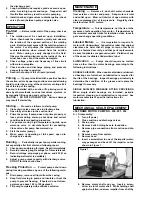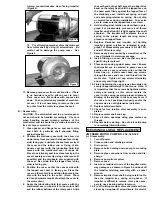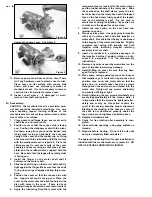
turning counterclockwise when facing impeller
(Figure 2).
10. Pry off rotating member of mechanical seal
from motor shaft by using (2) screwdrivers. Be
careful not to damage the pump cover. See
Figure 3.
11. Remove pump cover from cast iron disc. (There
is no hardware used to attach cover to disc.)
Place cover on a flat surface with convex side
down. Push out stationary member of mechani-
cal seal. It is not necessary to remove the cast
iron disc from the motor to replace the seal.
B.) Reassembly:
CAUTION: The mechanical seal is a precision prod-
uct and should be handled accordingly. Use care
when handling lapped running surfaces of the
mechanical seal to ensure they remain clean and are
free of chips or scratches.
1.
Clean gasket and flange faces, seal seat cavity
and shaft, in particular shaft shoulder fitting
against impeller.
2.
Position the stationary seat with the silver dot
down (away from you) and the lapped face (shiny
side) facing you. Lubricate the seal seat cavity of
the cover and the rubber cup or O-ring of sta-
tionary seal seat with the lubricating fluid that
comes with the mechanical seal or repair kit.
Press the stationary seat in seal seat cavity in the
cover squarely and evenly using a arbor press (if
possible) and the cardboard disc supplied with
the seal. Be certain that the lapped face (shiny
side) is facing you.
3.
Position the cover so that the convex side with
the lapped seal seat is facing you. Place the
cover on the motor disc and align the holes in the
disc with the holes in the cover. (Note: There
isn’t any hardware required to attach the cover to
the motor disc.)
4.
Apply the lubricating fluid that comes with the
mechanical seal or repair kit to the motor shaft
and the rubber bellows of the rotary seal. Slide
the seal head on the shaft, press the rubber drive
band on the rotary head until the lapped face on
the head seats firmly against the lapped face of
the stationary seat. Install seal spring on head
and seal spring retainer on spring. Do not chip
or scratch faces during installation. Take extra
care to make sure the lapped faces are clean.
5.
Hold shaft against rotation as described in para-
graph 8 of disassembly procedure, and thread
impeller on shaft until it is tight against the shaft
shoulder. The impeller will compress the seal
spring to the proper length assuring correct
pressure on lapped faces.
6.
Replace D-washer and impeller nut holding
impeller against rotation as indicated in para-
graph 7 of disassembly procedure (2 & 3 HP 1PH,
and all 3PH motors only).
7.
Remove any burrs caused by screwdriver on the
vane of impeller in waterway passage.
8.
Install O-Ring on cover. Be sure that any dam-
aged O-ring is replaced.
9.
Place pump casing against pump cover. Ensure
that impeller eye is centered in pump case and
position case, cover and motor disc so that the
holes line up. Install socket head cap screws
through the case and cover, and thread into the
motor disc. Tighten all cap screws alternately
and evenly until finger tight.
10. Finish tightening the cap screws alternately and
evenly to approximately 6 ft. lbs. torque. Note: It
is imperative that the screws be tightened alter-
nately and evenly, as this action centers the
cover in the casing, assuring proper alignment.
Binding of the impeller in the case may occur if
the case is not positioned properly and/or the
cap screws are not tightened as indicated.
11. Replace hold-down bolts.
12. Check for free rotation after assembly is com-
pleted.
13. Replace motor shaft end cap.
14. Seal all drain openings using pipe sealant on
threads.
15. Reprime before starting. Do not start until pump
is completely filled with water.
JM FRAME MOTOR, PUMP NO. 236, 320-328
A.) Disassembly:
1.
Turn off power.
2.
Close suction and discharge valves.
3.
Drain pump.
4.
Remove bolts holding down pump to mounting
plate.
5.
Remove pipe connections from suction and dis-
charge.
6.
Remove pump from system.
7.
Remove case.
8.
Insert a screwdriver in one of the impeller water-
way passages, as shown in Figure 4, and back off
the impeller retaining assembly with a socket
wrench.
9.
Remove impeller from shaft, being careful not to
lose the impeller key, spring and gasket. If
impeller is difficult to remove, it may be neces-
sary to use a bearing puller to remove.
10. Pry off rotating member of mechanical seal from
sleeve by using two (2) screwdrivers. Be careful
MECHANICAL SEAL REPLACEMENT
Figure 2
Figure 3






















